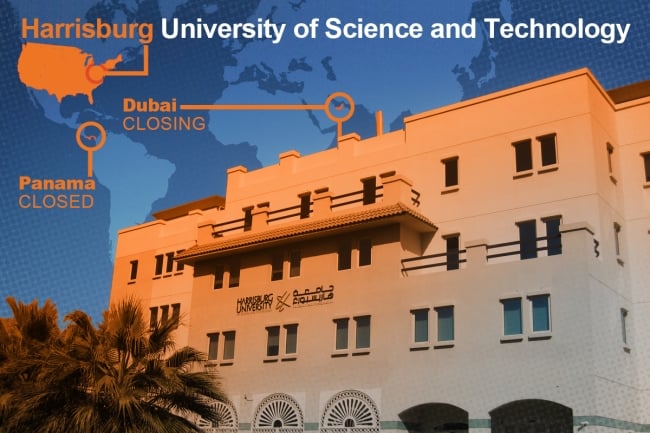You have /5 articles left.
Sign up for a free account or log in.

Harrisburg University has walked back plans for international expansion, reportedly due to finances.
Photo illustration by Justin Morrison/Inside Higher Ed | Stephen Wilkins
Harrisburg University of Science and Technology is closing campuses in Panama and Dubai, striking a hasty retreat from the international market it once pinned its enrollment hopes on.
The closures, announced at an employee town hall last month, come after Harrisburg’s Panama campus opened in 2022, followed by the U.A.E. location last year. The ambitious expansion, launched amid enrollment struggles at Harrisburg’s main campus in Pennsylvania, ended abruptly and with no public explanation from administrators on why the university was shutting down the two locations.
But in the absence of public statements, university financial documents tell a story of an institution battered by pandemic-related enrollment losses, struggling to keep up with bond payments and forced to cut costs as it navigates economic headwinds broadly affecting higher education.
Pulling Back
The closure news was first reported by local media organizations that viewed a live stream of a town hall for employees held last month. In that town hall, Harrisburg president Eric Darr told employees the university had already exited Panama and that Dubai would soon be next.
Local media outlets reported that video of the event was later deleted by the university.
Public financial documents confirm the university began “winding down” the Panama campus more than a year ago. Harrisburg’s Board of Trustees voted in June 2023 “to suspend operations in Panama” due to “the significant financial burden” ($1.5 million a year) of operating the campus “coupled with the very small student enrollment expectations,” financial documents show. However, officials noted the possibility of resuming operations in Panama at a different location and later date.
Harrisburg is currently in the process of retreating from Dubai as well, reportedly due to two major investors pulling their support, according to local media coverage of the town hall.
University officials declined to make leaders available for an interview with Inside Higher Ed and have yet to make a public announcement on the closures. Harrisburg spokesperson Jessica Warren would not confirm closure details but told Inside Higher Ed by email that “Harrisburg University continuously evaluates how to best serve our students—various modalities and locations are more effective for different populations and programs.”
“Changes are often necessary to ensure the long-term growth and sustainability of an organization. We are continuing to evaluate the best form and function for our international campuses in Dubai and Panama and are committed to educating students enrolled in those campuses,” Warren wrote, while also highlighting new academic programs on the main campus.
University statements paint a different picture than Darr reportedly did in the employee live stream, according to multiple local media reports. In last month’s town hall, he noted that the Dubai campus “had just enrolled the first students. We had a very successful campus grand opening and two investors in short order; for reasons that still remain unclear to me, they decided to withdraw their support. Given the financial challenges HU has in the U.S., the trustees decided we are done,” he said. “We are in the process of ceasing operations in the [United Arab Emirates].”
Harrisburg’s Financial Challenges
Harrisburg’s website notes the private, nonprofit institution, founded in 2001, was launched to “address the Capital Region’s need for increased educational opportunities in science, technology, engineering and math.” Harrisburg has had a rapid ascent, particularly over the last decade as it added programs.
In 2013, Harrisburg enrolled 354 students, according to federal data. By the 2019–20 academic year that number had soared to 6,915 students, most at the graduate level, according to public financial documents. But by the 2022–23 academic year, that number had fallen to 5,749 students.
A report by Kaludis Consulting noted the effect of the coronavirus pandemic on enrollment.
“As it did nationwide in higher education, once Covid hit, enrollments went down significantly throughout most of HU’s programs. This caused HU to lose a significant portion of its revenue, just when a large facility was being built to accommodate a growing and expanding program of academic offerings,” Kaludis Consulting officials wrote in a report issued in January 2023. “It is commendable that HU was able to continue to produce revenue at the level at which they did.”
In addition to Harrisburg’s slipping head count—an issue many institutions are grappling with, particularly those in Pennsylvania, where enrollment issues abound—the university has also undergone two rounds of layoffs in the past year and missed a $1.2 million bond payment in May.
Warren, the university spokesperson, noted in her email that bond payments “for June, July, and August were paid on time.”
The university has seen a reversal of fortunes on its balance sheet in recent years. In fiscal year 2021, Harrisburg reported a positive operating margin of $5.8 million. That number then slipped to negative $3.9 million in fiscal year 2022 and then to $8.4 million in the red for fiscal year 2023. Now, after reducing operating costs, officials expect positive operating margins. HU also increased student fees but has not raised undergraduate tuition in more than a decade.
International Campus Challenges
As Harrisburg University pulls back from Panama and Dubai, it is not alone. Several other U.S. institutions have also shuttered international branch campuses in recent years or announced plans to do so, though politics seems a more common factor than financial pressures.
Earlier this year, Texas A&M University announced it was leaving Qatar by 2028. The move came amid claims from the Institute for the Study of Global Antisemitism and Policy that Texas A&M was licensing nuclear energy and weapons development research to Qatar and that the Qataris were allegedly arming Hamas, which orchestrated the Oct. 7 terror attacks on Israel.
Texas A&M leaders rejected the claims as “false and irresponsible.” Still, the move baffled many observers, given that Texas A&M had collected more than $750 million on its last known 10-year contract. (Last year, Texas A&M declined to provide its latest contract to Inside Higher Ed, appealing to the Texas attorney general to withhold details in response to a record request.)
Earlier this year, Florida International University backed out of its joint campus with Tianjin University of Commerce in China due to a new state law that limits the ability of public universities to partner with or accept money from “countries of concern,” including China.
But even if Harrisburg remained in Dubai, experts believe challenges would have persisted.
"In the last few years, several international markets have become saturated with foreign higher education providers. Dubai is one such place, so it was always going to be an uphill struggle for Harrisburg University to succeed,” Stephen Wilkins, an expert on transnational education and formerly a professor at the British University in Dubai, told Inside Higher Ed by email.
He cited recent university closures in Dubai as well as falling enrollment for other institutions.
Given the costs of establishing international branch campuses, Wilkins noted that universities often require partnerships or outside funding sources to launch such endeavors so far away from home. However, he added, “foreign partners can be very fickle and withdraw their support without warning or proper explanation, which only adds to the risks of failure.”
“Institutions that are still considering the development of campuses in the Arab Gulf region have probably missed the boat, as most of these countries already have an oversupply of higher education providers. These institutions would be better off considering virgin markets like India and Indonesia, which may offer better medium-term potential, but not without risks too,” Wilkins said.




